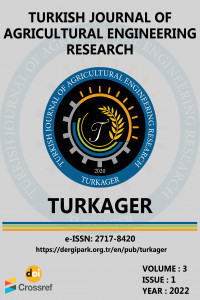Performance and Cost Comparison of Photovoltaic and Diesel Pumping Systems: In Central Rift Valley of Ethiopia
Performance and Cost Comparison of Photovoltaic and Diesel Pumping Systems: In Central Rift Valley of Ethiopia
Photovoltaic, Solar radiation, Pumps, Life cycle cost,
___
- Benghanem M, Daffallah O, Alamri N and Joraid A (2014). Effect of pumping head on solar water pumping system. Energy Conversion and Management, 77: 334-339.
- Chande S, Naik N and Chandel R (2017). Review of performance studies of direct coupled photovoltaic water pumping systems, a case study. Renewable Sustainable Energy Reviews,76: 163-175.
- Elrefai M and Hamdy R (2016). Design and performance evaluation of a solar water pumping system: A case study. Eighteenth International Middle East Power Systems Conference (MEPCON).
- Foster R, Argaw N, and Ellis A (2001). Renewable energy for water pumping applications ın rural villages; period of performance. April 1, 2001-September 1, 2001. United States: N. p., 2003. Web. https://doi.org/10.2172/15004054
- Girma M, Assefa A and Molinas M (2015). Feasibility study of a solar photovoltaic water pumping system for rural Ethiopia. AIMS Enviromental Science, 2(32): 697-717.
- Gouws R and Lukhwareni T (2012). Factors influencing the performance and efficiency of solar water pumping systems : A review. International Journal of Physical Sciences, 7(48): 69-80.
- Hartung H and Pluschke L (2018). The benefits and risks of solar powered irrigation-a global review. Food and Agricultural Organization.
- Hulluka TA, Balcha SK, Yohannes B, Bantider A and Negatu A (2023). Review: Groundwater research in the Ethiopian Rift Valley Lakes region. Frontiers in Water, 5: 819568.
- Maughan T, Drost D and Allen N (2015). Vegetable irrigation; Sweet pepper and sizing and testing of solar photovoltaic water pumping system for irrigation purposes tomato. Horticulture, 3: 1-5.
- Morales D and Busch J (2010). Design of small photovoltaic solar-powered water pump systems’, United States Department Agriculture and Natural resources Conservation Service.
- Narale P, Rathore S and Kothari S (2013). Study of solar pv water pumping system for ırrigation of horticulture crops. International Journal of Engineering Science Invention, 2(12): 54-60.
- Nasir A (2016). Design, simulation and analysis of photovoltaic water pumping system for ırrigation of a potato farm at Gerenbo. Masters Thesis, Addis Ababa Institute of Technology School of Graduate Studies School of Mechanical and Industrial Engineering, p.98.
- Osaretin A and Edeko F (2016). Design and implementation of a solar charge controller with variable output. Journal of Electrical and Electronic Engineering, 12(2): 40-50.
- Otoo M, Lefore N, Schmitter P, Barron J and Gebregziabher G (2018). Business model scenarios and suitability: smallholder solar pump-based irrigation in Ethiopia. Agricultural Water Management-Making a Business Case for Smallholders.
- Park S (2013). Fundamentals of engineering economics. Pearson International Edition, England.
- Sass J and Hahn A (2020). Solar Powered Irrigation Systems (SPIS), Deutsche Gesellschaft für Internationale Zusammenarbeit (GIZ) GmbH, Bonn.
- Villalobos J and Fereres E (2016). Principles of Agronomy for Sustainable Agriculture, Springer, Switherland.
- Zadi D and Bamford E (2016). Scaling up solar powered water supply systems: A review of experiences, UNICEF.
- Zaki M and Eskander N (1996). Matching of photovoltaic motor-pump systems for maximum efficiency operation. Renewable Energy, 7(3): 279-288.
- Zegeye M, Tadiwos T and Aman A (2014). Optimal sizing of solar water pumping system for small scale irrigation : Case study of Dangila. International Journal of Sustainable and Green Energy, 3(5): 99-107.
- Yayın Aralığı: Yılda 2 Sayı
- Başlangıç: 2020
- Yayıncı: Ebubekir ALTUNTAŞ
Uğur ÖZKAN, Nesim YILDIZ, Celal PEKER
A microcontroller - Based Irrigation Scheduling Using FAO Penman-Monteith Equation
Olugbenga Kayode OGİDAN, Samuel Dare OLUWAGBAYIDE, Thomas ALE
Maney Ayalew DESTA, Getachew Shunki TİBBA, Mubarek Mohammed ISSA, Wariso HEYİ
Development of a Cowpea Threshing Machine
Mohamed MANSOUR SHALABY REFAAAY, Ahmed SHAWKY EL-SAYED, Mokhtar COTTB AHMED AWAD
Development and Performance Evaluation of a Hand Operated Maize Sheller
Muyıwa OKUSANYA, Francis AGBONGİABAN
Mathematically Predicting the Performance Rate of Plow-Type Trenchless Machine
Abdelgawad SAAD, Hani MANSOUR, Elsayed ALİ, Mostafa AZAM
Simulation-Optimization Modelling of Yield and Yield Components of Tomato Crop
Nura Jafar SHANONO, Lawal AHMAD, Nuraddeen Mukhtar NASİDİ, Abdul'aziz Nuhu JİBRİL, Mukhtar Nuhu YAHYA
